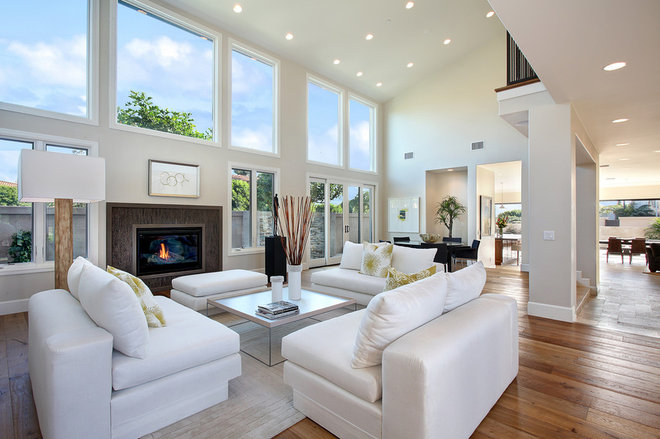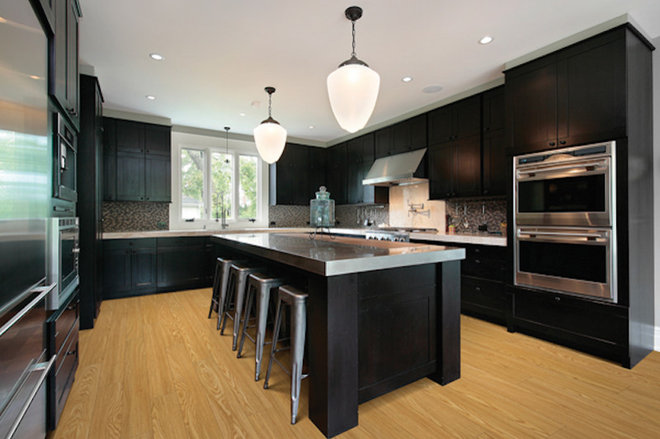3 Reasons to Love Recessed Lights and 3 Things to Watch Out For
Consider these pros and cons before including can lights in your room design
by David Warfel February 17, 2018
Recessed downlights, sometimes called can lights, are a feature of many well-lit homes and a favorite tool of professional lighting designers. These often-discreet fixtures are great for adding drama or lighting countertops, but they can also create overly dark interiors and even blinding glare. Here are three brilliant upsides to downlights and three common downsides to consider before installing them.
Why do many design professionals love downlights? Because when it comes to adding drama, creating pushed (focused) light or concealing a light source, recessed fixtures are an ideal choice.
Pros
1. Dramatic light. Like a spotlight on a stage, a strong beam of light shining on a prized painting or statue draws our attention. Recessed downlights can also add significant drama to a space by highlighting architectural features like the stone face on this fireplace.
1. Dramatic light. Like a spotlight on a stage, a strong beam of light shining on a prized painting or statue draws our attention. Recessed downlights can also add significant drama to a space by highlighting architectural features like the stone face on this fireplace.
2. Pushed, or focused, light. Ambient light sources like pendants and lamps are not great at “pushing” usable light down to countertops, tables and reading chairs because their light beams break up before reaching their destination. Recessed downlights do this better. They also excel at illuminating double-height spaces, like the one shown here, especially when used with narrow beam spreads.
The narrower a light beam is, the stronger it will shine on a particular spot. A spotlight, for example, provides a strong, focused beam of light, whereas a floodlight provides a wider but less-focused beam.
The narrower a light beam is, the stronger it will shine on a particular spot. A spotlight, for example, provides a strong, focused beam of light, whereas a floodlight provides a wider but less-focused beam.
3. Hidden light. Nothing beats a recessed downlight for delivering lumens discreetly. Sizes of recessed lights are getting smaller and smaller. Standard 6-inch cans are giving way to 2- and 3-inch cans, resulting in a more streamlined, cleaner-looking ceiling.
But like most things in life, recessed lights are not perfect. Three common problems created by recessed downlights are the “cave effect,” “glare bombs” and “energy exits.”
Cons
1. Cave effect. Lighting designers refer to the cave effect when describing rooms with recessed downlights that leave walls looking dark. This may be just right in a home theater like this one, but other rooms often need more layers of light to create a bright, comfortably lit space.
1. Cave effect. Lighting designers refer to the cave effect when describing rooms with recessed downlights that leave walls looking dark. This may be just right in a home theater like this one, but other rooms often need more layers of light to create a bright, comfortably lit space.
2. Glare bombs. Though they are usually marketed as “recessed” downlights, some new LED fixtures are barely recessed at all. With as little as a quarter of an inch of recess and a bright frosted lens, these fixtures can be glare bombs that contribute to eyestrain, headaches and fatigue. This is especially true in open spaces where we relax and sit for long periods.
In this bright kitchen, however, the shallow LED fixtures along the room perimeter do a good job of illuminating upper cabinets. But for overall ambient lighting, stick with deeper recessed flxtures.
In this bright kitchen, however, the shallow LED fixtures along the room perimeter do a good job of illuminating upper cabinets. But for overall ambient lighting, stick with deeper recessed flxtures.
3. Energy exits. Recessed downlights are targets of energy specialists, as they create holes in the ceiling that can let heat out during the winter and in during the summer. To minimize the costs and discomfort of energy loss, many manufacturers offer air-sealed or insulation-rated fixtures that limit heat loss. On an uninsulated porch like this one, however, there is no need to worry about heat loss.
Cabinet-S-Top
1977 Medina Road
Medina, OH 44256
330.239.3630
www.cabinet-s-top.com
Cabinet-S-Top
1977 Medina Road
Medina, OH 44256
330.239.3630
www.cabinet-s-top.com
- Get link
- X
- Other Apps











Great Blog!! Thanks for sharing this with us. As I am looking for a Best Tile Company In Haryana. Please suggest me if possible.
ReplyDeleteReally I am very impressed with this post. Just awesome... I haven’t any word to appreciate this post. Keep sharing.
ReplyDeleteRenovations